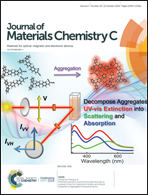Hydrogenated PtP2 monolayer: theoretical predictions on the structure and charge carrier mobility
Abstract
Two-dimensional semiconducting materials have attracted intensive attention due to their superior transport and optical properties and their potential applications in future nanoscale devices. However, the number of wide band gap two-dimensional (2D) materials is still limited in all known 2D materials. In this study, by means of the particle-swarm optimization method and density functional theory calculations, we predicted a new wide gap 2D anisotropic material, a hydrogenated PtP2 monolayer (PtP2H2). The structure is found to be stable thermally, dynamically, and mechanically and exhibits an anisotropic mechanical behavior with respect to the Young's modulus and Possion's ratio. Using the hybrid functional of Heyd–Scuseria–Ernzerhof (HSE06) calculations to calculate the band structure of PtP2H2 indicate that the structure is a wide gap semiconductor with an indirect band gap of 3.34 eV. According to the deformation potential theory, the HSE calculations for the carrier mobility reveal that PtP2H2 has higher carrier mobilities along the b direction (2.38 × 103 for electrons and 2.26 × 103 cm2 V−1 s−1 for holes, respectively) than those along the a direction (1.74 × 103 for electrons and 1.06 × 103 cm2 V−1 s−1 for holes, respectively), and it shows anisotropy in-plane. Furthermore, PtP2H2 exhibits strong optical absorption in the ultraviolet region. Our calculations suggest that PtP2H2 has potential applications in optoelectronics owing to its wide band gap and high carrier mobility.



 Please wait while we load your content...
Please wait while we load your content...